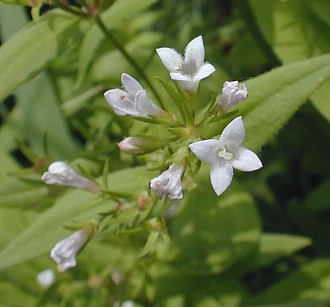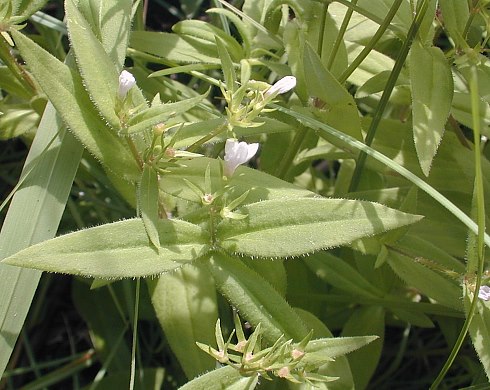Description:
This
perennial plant is up to 1' tall, branching occasionally and
rather bushy when mature. There are scattered hairs along the stems,
and the opposite leaves are ciliate, but without serration. The leaves
are oblong-lanceolate, broadly lanceolate, or ovate. Each leaf is about
1-2" long and about
one-third as wide, with a prominent central vein and a smooth texture.
At the ends of the stems are clusters of small flowers. These flowers
are usually white or light purple, but sometimes a darker shade of
purple. Each flower is about ¼" across, with a short tubular shape and
four lobes that flare outward. The reproductive parts are white, except
for the light brown anthers. The flowers bloom during late spring or
early summer for about a month. There is no floral scent. The small
seeds are distributed to some extent by the wind. The root system
consists of a branching taproot.
texture.
At the ends of the stems are clusters of small flowers. These flowers
are usually white or light purple, but sometimes a darker shade of
purple. Each flower is about ¼" across, with a short tubular shape and
four lobes that flare outward. The reproductive parts are white, except
for the light brown anthers. The flowers bloom during late spring or
early summer for about a month. There is no floral scent. The small
seeds are distributed to some extent by the wind. The root system
consists of a branching taproot.
Cultivation:
The preference is full or partial sun, and moist to slightly dry soil.
This plant typically grows in soil that is loamy or rocky. It is not
usually bothered by foliar disease, and is one of the easier bluets to
maintain in an average garden situation.
Range & Habitat:
The native Lance-Leaved Bluets occurs occasionally in the southern half
of
Illinois, while in the northern half of the state it is rare or absent
(see Distribution
Map). Habitats include mesic black soil prairies, rocky
upland forests, rocky bluffs, limestone glades, borders of lakes, and
pastures. This wildflower is found primarily in higher quality natural
areas.
Faunal Associations:
The flowers attract long-tongued bees, short-tongued bees, flies, small
butterflies, skippers, and beetles. Bee visitors include Little
Carpenter bees, Nomadine Cuckoo bees, Halictine bees, and Panurgine
bees. Other common insect visitors include Syrphid flies, Checkerspot
butterflies, Copper butterflies, White butterflies, and Flower Scarab
beetles. The seeds of this plant are too small to be of much interest
to birds. Limited information is available regarding this plant's
attractiveness to mammalian herbivores.
Photographic Location: The photographs were taken at Loda Cemetery Prairie in Iroquois County, Illinois.

Comments: This unassuming little plant is a good candidate for a rock garden, in either sunny or partial shaded areas. It is easily overlooked in the wild, but when it is found in bloom this is always a pleasant surprise. Lance-Leaved Bluets can be distinguished from other bluets by the wideness of its leaves – up to 2/3" (17 mm.) across. Other species of bluets in Illinois have narrow to very narrow leaves. An exception is Houstonia purpurea (Wide-Leaved Bluets), which has leaves up to 1¼" wide, sometimes with 3 conspicuous veins. This latter species occurs primarily in woodland areas in extreme southern Illinois. Lance-Leaved Bluets is sometimes considered a variety of this species: Hedyotis purpurea calycosa or Houstonia purpurea calycosa, depending on the authority.